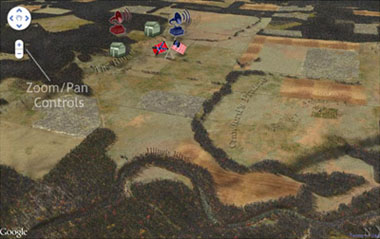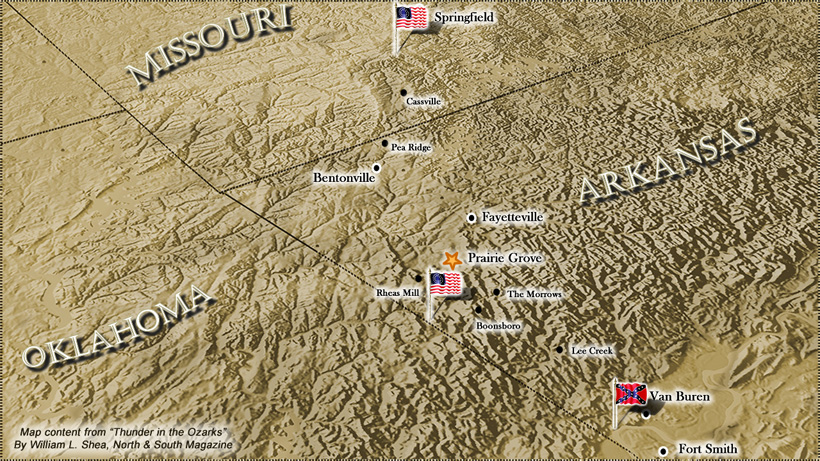Explore the Battle
-

Instructions
Click on the timeline to access battle events hour-by-hour. Zoom in and explore each interactive map using the zoom/pan controls.
Select the different map icons to learn more about troop movements, hear audio segments detailing personal accounts, and view images of key structures within the battle area. Video segments from the Watch the battle section are also available for each hour.
-


The days before...
In the days leading up to the Battle of Prairie Grove, both the Union and Confederate forces were organizing in the area. Confederate General Thomas Hindman assembled a small army comprised of some 11,000 men near Van Buren. Hindman's army was within 30 miles of Union General James Blunt's division while Union General Francis Herron was over 100 miles away in Springfield. On December 3rd, Hindman and his men moved north in an effort to attack Blunt.
When Blunt learned of the upcoming attack, he decided to hold fast and send for Herron. Upon receiving word, Herron set out from Springfield on December 4th. By December 6th, Hindman reached the Morrow Farm east of Cane Hill with the intent to strike on Blunt. Late that evening however, Hindman received news that Herron's relief column was nearing Fayetteville, indicating that Herron had made the trek from Springfield in 3 ½ days. Stunned by Herron's advances, Hindman had to hastily change plans and decided to defer his attack on Blunt and move forward to advance on Herron.
-



8-9am
Early in the morning of the December 7th, General Hindman moves north in an effort to intercept Herron. His cavalry led by General Marmaduke encounters Union cavalry near the Prairie Grove Church where they skirmish briefly and the Federals retreat back across the river. The Confederates pursue and encounter Herron's main column that is fast approaching from Fayetteville. After a brief skirmish, they return to the ridge on the west side of the river.
-



9-10am
Around 9 am General Shoup arrives on the ridge and is informed that Herron is just across the river. He decides to hold fast on the ridge and await the advances of Herron. He and Marmaduke begin to get their men into formation.
-



10-11am
At 10 o'clock, Herron reaches the river and can see the Rebel forces in formation amongst the trees on the ridge. He attempts to cross but is driven back by Confederate artillery.
-



11-12am
By 11 o'clock, the Rebel forces composed of some 5,000 men are in formation on the ridge. For the next hour, Herron deploys the 3rd division on the east side of the river while his staff searches for another way to cross the Illinois.
-



12-1pm
The rest of Herron's column led by Colonel Huston arrives around noon which coincides with the discovery of the 2nd river crossing to the north. Huston and his men go to work cutting a road through the trees to access the new ford. The men clear the road in less than an hour, and just before 1 o'clock Murphy's battery splash across the new ford. With the heavy artillery now in place on Crawfords Hill, Herron directs Colonel Orme's brigade to cross the lower ford of the Illinois.
-



1-2pm
Around 1:30, Shoup begins to get impatient at the lack of activity and orders a single canon fire across the prairie. Murphy responds with a series of canon fires that “shattered the midday calm.” The two forces exchange fire for over half an hour but the Rebels have a much harder time trying to pinpoint the position and range of Murphy's guns which encourages General Herron to mount his next move.
-



2-3pm
Around 2:15, Herron orders an attack on the ridge. Two Union regiments clash with Southern forces around the Borden House and orchard. The fighting was intense and with the Union forces suffering nearly 50% casualties, they fell back into the valley below. The rebels immediately pursue only to be gunned down by the awaiting Union artillery line.
-



3-4pm
Just after 3 o'clock, Herron orders a second counter attack on the ridge led by Colonel Huston. Huston and his troops press the ridge and encounter the Rebels in the fatal Borden orchard. The second Union attack mirrors the first and the Union forces quickly retreat with the Rebels at their heels yet again. The second Rebel counter attack marks the end of the battle on the east side of the ridge.
At around 3:15, Blunt announces his arrival on the knoll by the West House at the northwest corner of the battlefield. Dismayed by the arrival of Blunt to the northwest, Hindman orders the remainder of his army lead by General Frost north to the ridge. Just before 4:00 o'clock, Blunt's canons open fire on the western side of the ridge. Under cover of fire, Blunts men form a line on Crawford's Prairie.
-



4-6pm
Shortly after 4:00 o'clock Blunts men attack the ridge near the Morton House. Unable to drive off the Rebels, Blunt pulls back around 5:00 o'clock and the rebels pursue only to be driven back to the ridge by the waiting Union artillery line.
Just after 5:00the Confederates launch one final attack to try and win the day but were driven back. Around 5:45pm, night falls on the battle. That night, Hindman concludes that they do not have enough ammunition and supplies to fight another day. The Union forces continue to grow that night as stragglers from Herron's march file in to the area. Around midnight, Hindman's men slip away quietly on Cove Creek Road with the wheels of their artillery wrapped in blankets to muffle the sound of their retreat. The Union troops awake the next morning to find the Confederates are gone.
-



The days after…
While the battle technically ended in a draw, the Confederates midnight retreat allowed the Federals to claim victory. 2,700 men were killed or wounded in the Battle of Prairie Grove. For weeks following the battle, men from both sides tended to the dead and wounded. Homes throughout the area were used as hospitals. On the day after the battle, Union forces burnt the homes of Archibald Borden, William Rogers, Ed Rogers and White Taylor to the ground. The West house was used a temporary hospital for Union troops and Herron set up temporary headquarters in Hugh Rogers house. The Union forces remained in the area for months before withdrawing. The Battle of Prairie Grove was the last major campaign in Northwest Arkansas.
